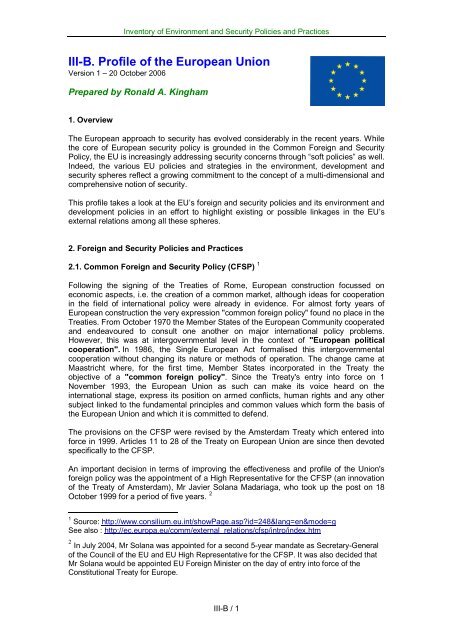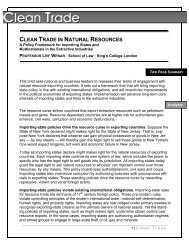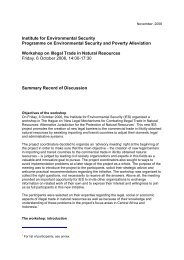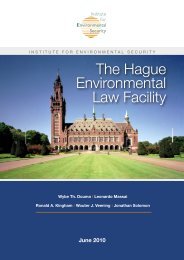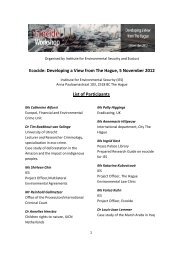III-B. Profile of the European Union - Institute for Environmental ...
III-B. Profile of the European Union - Institute for Environmental ...
III-B. Profile of the European Union - Institute for Environmental ...
Create successful ePaper yourself
Turn your PDF publications into a flip-book with our unique Google optimized e-Paper software.
Inventory <strong>of</strong> Environment and Security Policies and Practices<strong>III</strong>-B. <strong>Pr<strong>of</strong>ile</strong> <strong>of</strong> <strong>the</strong> <strong>European</strong> <strong>Union</strong>Version 1 – 20 October 2006Prepared by Ronald A. Kingham1. OverviewThe <strong>European</strong> approach to security has evolved considerably in <strong>the</strong> recent years. While<strong>the</strong> core <strong>of</strong> <strong>European</strong> security policy is grounded in <strong>the</strong> Common Foreign and SecurityPolicy, <strong>the</strong> EU is increasingly addressing security concerns through “s<strong>of</strong>t policies” as well.Indeed, <strong>the</strong> various EU policies and strategies in <strong>the</strong> environment, development andsecurity spheres reflect a growing commitment to <strong>the</strong> concept <strong>of</strong> a multi-dimensional andcomprehensive notion <strong>of</strong> security.This pr<strong>of</strong>ile takes a look at <strong>the</strong> EU’s <strong>for</strong>eign and security policies and its environment anddevelopment policies in an ef<strong>for</strong>t to highlight existing or possible linkages in <strong>the</strong> EU’sexternal relations among all <strong>the</strong>se spheres.2. Foreign and Security Policies and Practices2.1. Common Foreign and Security Policy (CFSP) 1Following <strong>the</strong> signing <strong>of</strong> <strong>the</strong> Treaties <strong>of</strong> Rome, <strong>European</strong> construction focussed oneconomic aspects, i.e. <strong>the</strong> creation <strong>of</strong> a common market, although ideas <strong>for</strong> cooperationin <strong>the</strong> field <strong>of</strong> international policy were already in evidence. For almost <strong>for</strong>ty years <strong>of</strong><strong>European</strong> construction <strong>the</strong> very expression "common <strong>for</strong>eign policy" found no place in <strong>the</strong>Treaties. From October 1970 <strong>the</strong> Member States <strong>of</strong> <strong>the</strong> <strong>European</strong> Community cooperatedand endeavoured to consult one ano<strong>the</strong>r on major international policy problems.However, this was at intergovernmental level in <strong>the</strong> context <strong>of</strong> "<strong>European</strong> politicalcooperation". In 1986, <strong>the</strong> Single <strong>European</strong> Act <strong>for</strong>malised this intergovernmentalcooperation without changing its nature or methods <strong>of</strong> operation. The change came atMaastricht where, <strong>for</strong> <strong>the</strong> first time, Member States incorporated in <strong>the</strong> Treaty <strong>the</strong>objective <strong>of</strong> a "common <strong>for</strong>eign policy". Since <strong>the</strong> Treaty's entry into <strong>for</strong>ce on 1November 1993, <strong>the</strong> <strong>European</strong> <strong>Union</strong> as such can make its voice heard on <strong>the</strong>international stage, express its position on armed conflicts, human rights and any o<strong>the</strong>rsubject linked to <strong>the</strong> fundamental principles and common values which <strong>for</strong>m <strong>the</strong> basis <strong>of</strong><strong>the</strong> <strong>European</strong> <strong>Union</strong> and which it is committed to defend.The provisions on <strong>the</strong> CFSP were revised by <strong>the</strong> Amsterdam Treaty which entered int<strong>of</strong>orce in 1999. Articles 11 to 28 <strong>of</strong> <strong>the</strong> Treaty on <strong>European</strong> <strong>Union</strong> are since <strong>the</strong>n devotedspecifically to <strong>the</strong> CFSP.An important decision in terms <strong>of</strong> improving <strong>the</strong> effectiveness and pr<strong>of</strong>ile <strong>of</strong> <strong>the</strong> <strong>Union</strong>'s<strong>for</strong>eign policy was <strong>the</strong> appointment <strong>of</strong> a High Representative <strong>for</strong> <strong>the</strong> CFSP (an innovation<strong>of</strong> <strong>the</strong> Treaty <strong>of</strong> Amsterdam), Mr Javier Solana Madariaga, who took up <strong>the</strong> post on 18October 1999 <strong>for</strong> a period <strong>of</strong> five years. 21 Source: http://www.consilium.eu.int/showPage.asp?id=248&lang=en&mode=gSee also : http://ec.europa.eu/comm/external_relations/cfsp/intro/index.htm2 In July 2004, Mr Solana was appointed <strong>for</strong> a second 5-year mandate as Secretary-General<strong>of</strong> <strong>the</strong> Council <strong>of</strong> <strong>the</strong> EU and EU High Representative <strong>for</strong> <strong>the</strong> CFSP. It was also decided thatMr Solana would be appointed EU Foreign Minister on <strong>the</strong> day <strong>of</strong> entry into <strong>for</strong>ce <strong>of</strong> <strong>the</strong>Constitutional Treaty <strong>for</strong> Europe.<strong>III</strong>-B / 1
<strong>Pr<strong>of</strong>ile</strong> <strong>of</strong> <strong>the</strong> <strong>European</strong> <strong>Union</strong>The new Treaty <strong>of</strong> Nice entered into <strong>for</strong>ce on 1 February 2003 and contains new CFSPprovisions. It notably increases <strong>the</strong> areas which fall under qualified majority voting andenhances <strong>the</strong> role <strong>of</strong> <strong>the</strong> Political and Security Committee in crisis managementoperations.The CFSP ObjectivesThe Treaty on <strong>European</strong> <strong>Union</strong> defines <strong>the</strong> objective <strong>of</strong> CFSP as “to preserve peace andstreng<strong>the</strong>n international security, in accordance with <strong>the</strong> principles <strong>of</strong> <strong>the</strong> United NationsCharter, as well as <strong>the</strong> principles <strong>of</strong> <strong>the</strong> Helsinki Final Act and <strong>the</strong> objectives <strong>of</strong> <strong>the</strong> ParisCharter to promote international cooperation”. The CFSP has 5 main aims:• Safeguard <strong>the</strong> common values, fundamental interests, independence andintegrity <strong>of</strong> <strong>the</strong> <strong>Union</strong>• Streng<strong>the</strong>n <strong>the</strong> security <strong>of</strong> <strong>the</strong> <strong>Union</strong> in all ways• Preserve peace and streng<strong>the</strong>n international security• Promote international co-operation• Develop and consolidate democracy and <strong>the</strong> rule <strong>of</strong> law, and respect <strong>for</strong> humanrights and fundamental freedoms.It can be expected that <strong>the</strong> CFSP will increasingly address issues linked to environmentalsecurity, <strong>for</strong> example and especially as <strong>the</strong>y pertain to <strong>the</strong> potential threats <strong>of</strong> bioterrorism,including rapid detection and alert concerning chemical agents andsurveillance <strong>of</strong> sensitive areas, such as water reservoirs and nuclear sites. Some <strong>of</strong> <strong>the</strong>sekinds <strong>of</strong> concerns are already reflected in in<strong>for</strong>mation about <strong>the</strong> EU security researchinitiative. 32.2. <strong>European</strong> Security and Defence Policy (ESDP) 4The ESDP is an extension <strong>of</strong> <strong>the</strong> CFSP and was adopted in 2003 as <strong>the</strong> militarycomponent designed to streng<strong>the</strong>n <strong>the</strong> EU’s overall capacity <strong>for</strong> dealing with crisis anddisaster situations in member countries as well as o<strong>the</strong>r regional conflicts. The ESDPmakes it possible <strong>for</strong> <strong>the</strong> EU to launch humanitarian and peace missions to resolveinstances <strong>of</strong> crisis or conflict. In order to enable <strong>the</strong> <strong>European</strong> <strong>Union</strong> fully to assume itsresponsibilities <strong>for</strong> crisis management, <strong>the</strong> <strong>European</strong> Council (Nice, December 2000)decided to establish <strong>the</strong> following permanent political and military structures.• The Political and Security Committee (PSC) 5• The <strong>European</strong> <strong>Union</strong> Military Committee (EUMC) 6• The <strong>European</strong> <strong>Union</strong> Military Staff (EUMS) 73 See in<strong>for</strong>mation on <strong>the</strong> EU security research initiative at:http://ec.europa.eu/comm/external_relations/cfsp/news/memo03_192.htm4 See: http://www.consilium.eu.int/cms3_fo/showPage.asp?id=261&lang=en&mode=g5 See: COUNCIL DECISION <strong>of</strong> 22 January 2001 setting up <strong>the</strong> Political and SecurityCommittee at:http://www.consilium.europa.eu/uedocs/cmsUpload/l_02720010130en00010003.pdf6 For more in<strong>for</strong>mation on <strong>the</strong> EUMC see:http://www.consilium.eu.int/cms3_fo/showPage.asp?id=1065&lang=en and COUNCILDECISION <strong>of</strong> 22 January 2001 setting up <strong>the</strong> Military Committee <strong>of</strong> <strong>the</strong> <strong>European</strong> <strong>Union</strong>http://www.consilium.europa.eu/uedocs/cmsUpload/l_02720010130en00040006.pdf7 For more in<strong>for</strong>mation on <strong>the</strong> EUMS see:http://www.consilium.eu.int/cms3_fo/showPage.asp?id=1039&lang=en<strong>III</strong>-B / 2
Inventory <strong>of</strong> Environment and Security Policies and PracticesAccording to <strong>the</strong> Commission’s web pages on <strong>the</strong> CFSP and <strong>the</strong> ESDP: 8“The fact that security is becoming a wider concept reflects developmentsunderway since at least <strong>the</strong> energy crisis <strong>of</strong> <strong>the</strong> early 1970`s. This evolutionclearly accelerated after <strong>the</strong> end <strong>of</strong> <strong>the</strong> Cold War. Fur<strong>the</strong>rmore, traditionally,security has been analysed and managed from state and alliance perspectives.Now, <strong>the</strong> geographical pertinence <strong>of</strong> security issues has widened to include bothsub-national and global levels. Similarly, <strong>the</strong> scope has widened from <strong>the</strong> purelymilitary to include broader political, economic, social and environmental aspects.”2.3. <strong>European</strong> Security Strategy (ESS) 9The <strong>European</strong> Security Strategy was approved by <strong>the</strong> <strong>European</strong> Council held in Brusselson 12 December 2003 and drafted under <strong>the</strong> responsibilities <strong>of</strong> <strong>the</strong> EU HighRepresentative Javier Solana.The ESS is <strong>the</strong> policy document that guides <strong>the</strong> EU’s international security strategy. Itaddresses <strong>the</strong> need <strong>for</strong> a comprehensive security strategy that encompasses both civiland defence-related security measures. The Strategy itself is not necessarily anoperational document with a detailed plan <strong>of</strong> action. Ra<strong>the</strong>r it lays down overall objectives<strong>of</strong> EU external actions and <strong>the</strong> principal ways <strong>of</strong> achieving <strong>the</strong>se. With <strong>the</strong> emergence <strong>of</strong><strong>the</strong> ESDP, it is <strong>the</strong> first time that Europe has actually <strong>for</strong>mulated a joint security strategy.The ESS includes a number <strong>of</strong> references linking security, development andenvironment, including <strong>the</strong> statement that:“Security is a precondition <strong>of</strong> development. Conflict not only destroysinfrastructure, including social infrastructure; it also encourages criminality, detersinvestment and makes normal economic activity impossible. A number <strong>of</strong>countries and regions are caught in a cycle <strong>of</strong> conflict, insecurity and poverty.Competition <strong>for</strong> natural resources - notably water - which will be aggravated byglobal warming over <strong>the</strong> next decades, is likely to create fur<strong>the</strong>r turbulence andmigratory movements in various regions.”According to <strong>the</strong> Strategy "<strong>the</strong> development <strong>of</strong> a stronger international society, wellfunctioning international institutions and a rule-based international order" is one <strong>of</strong> <strong>the</strong>strategic objectives <strong>of</strong> <strong>European</strong> security policy.In speaking <strong>of</strong> <strong>the</strong> scope <strong>of</strong> <strong>the</strong> ESS at <strong>the</strong> May 2006 GLOBE-EU / IES Symposium onSecurity and Sustainable Development, 10 Dr. Robert Cooper 11 <strong>of</strong> <strong>the</strong> Council <strong>of</strong> <strong>the</strong><strong>European</strong> <strong>Union</strong> explained that when <strong>the</strong> ESS was first drafted, <strong>the</strong> intention was actuallyand <strong>the</strong> COUNCIL DECISION <strong>of</strong> 10 May 2005 on <strong>the</strong> establishment <strong>of</strong> <strong>the</strong> Military Staff <strong>of</strong> <strong>the</strong><strong>European</strong> <strong>Union</strong> at:http://www.eurlex.europa.eu/LexUriServ/site/en/oj/2005/l_132/l_13220050526en00170024.pdfand8 See: http://ec.europa.eu/comm/external_relations/cfsp/esdp/index.htm9 See: A SECURE EUROPE IN A BETTER WORLD - THE EUROPEAN SECURITYSTRATEGY at: http://www.consilium.eu.int/uedocs/cmsUpload/78367.pdf10 See: http://www.envirosecurity.org/ges/symposium/ The summary report <strong>of</strong> <strong>the</strong> symposiumis at: http://www.envirosecurity.org/ges/symposium/SDSSymposiumSummaryReport.pdf11 Dr. Cooper is Director General, DGE-External and Politico Military Affairs, Council <strong>of</strong> <strong>the</strong><strong>European</strong> <strong>Union</strong><strong>III</strong>-B / 3
<strong>Pr<strong>of</strong>ile</strong> <strong>of</strong> <strong>the</strong> <strong>European</strong> <strong>Union</strong>to restrict its ambit to those threats caused by humans in order to create a manageableand viable regime. The main types <strong>of</strong> threats addressed by <strong>the</strong> ESS include: terrorism,weapons <strong>of</strong> mass destruction, regional conflicts, state failure.Despite its ra<strong>the</strong>r restricted ambit, Dr. Cooper stressed that <strong>the</strong> ESS approach has notbeen entirely conventional. He acknowledged that threats are changing as a result <strong>of</strong>increased interdependence, with one very big difference emerging from <strong>the</strong> globalisationphenomenon that “o<strong>the</strong>r peoples’ wars and conflicts matter”. As well, <strong>the</strong>re areincreasingly clear environmental dimensions to <strong>the</strong>se security threats, which haveimportant implications <strong>for</strong> <strong>the</strong> development <strong>of</strong> peace and security policy. For example,weapons <strong>of</strong> mass destruction, if used, could have dramatic environmental consequencesand regional conflict and state failure are intimately connected to poverty andenvironmental degradation. Ano<strong>the</strong>r interesting point raised was that state failure is “ara<strong>the</strong>r peculiar case <strong>of</strong> underdevelopment”, especially when seen against <strong>the</strong> broaderbackdrop <strong>of</strong> development policy aims, namely “to develop <strong>the</strong> state, democraticinstitutions and <strong>the</strong> rule <strong>of</strong> law”.2.4. Conflict Prevention and Crisis Management: 12In its 2001 Communication on Conflict Prevention 13 , <strong>the</strong> Commission addresses <strong>the</strong>‘root causes <strong>of</strong> conflict’ by promoting ‘structural stability’. The latter is defined as‘sustainable economic development, democracy and respect <strong>for</strong> human rights, viablepolitical structures and healthy environmental and social conditions, with <strong>the</strong> capacity tomanage change without resort to conflict’. The EU Programme <strong>for</strong> <strong>the</strong> Prevention <strong>of</strong>Violent Conflicts 14 that is based on this communication calls <strong>for</strong> an integrated policy,surpassing <strong>the</strong> pillar structure, and defines conflict prevention as a priority <strong>for</strong> all <strong>of</strong> <strong>the</strong>EU’s external action. Social and environmental policies are expressly mentioned among<strong>the</strong> means at <strong>the</strong> disposal <strong>of</strong> <strong>the</strong> EU to support conflict prevention ef<strong>for</strong>ts.In his remarks at <strong>the</strong> above mentioned symposium, Dr. Cooper outlined <strong>the</strong> EU’sresponse in a number <strong>of</strong> conflict zones, where it is endeavouring to advance security and12 For more in<strong>for</strong>mation on <strong>the</strong> EU and Conflict Prevention and Crisis Management see <strong>the</strong>following sources:Overview on Conflict Prevention and Crisis Management:http://ec.europa.eu/comm/external_relations/cfsp/cpcm/index.htmIQSG Programming Fiche on Conflict Prevention:http://europa.eu.int/comm/external_relations/cfsp/cpcm/cp/doc/cp_guide.pdfConflict Prevention Partnership, pilot project supported by <strong>the</strong> EC:http://www.conflictprevention.net/Civilian instruments <strong>for</strong> EU crisis management at:http://ec.europa.eu/comm/external_relations/cfsp/doc/cm03.pdfCommunication from <strong>the</strong> Commission to <strong>the</strong> Council and <strong>the</strong> <strong>European</strong> Parliament –Financing <strong>of</strong> Civilian Crisis Management Operations, COM(2001) 647 final:http://europa.eu.int/comm/external_relations/cfsp/doc/com01_647.pdfCommunication from <strong>the</strong> Commission to <strong>the</strong> Council and <strong>the</strong> <strong>European</strong> Parliament, <strong>the</strong><strong>European</strong> Economic and Social Committee and <strong>the</strong> Committee <strong>of</strong> <strong>the</strong> Regions -- Rein<strong>for</strong>cingEU Disaster and Crisis Response in third countries, COM(2005) 153 final:http://europa.eu.int/comm/external_relations/cfsp/cpcm/com05_153_en.pdf13 Communication from <strong>the</strong> Commission on Conflict Prevention, COM(2001) 211 final:http://europa.eu.int/comm/external_relations/cfsp/news/com2001_211_en.pdf14 See: http://www.eu2001.se/static/eng/pdf/violent.PDF<strong>III</strong>-B / 4
Inventory <strong>of</strong> Environment and Security Policies and Practicesstability on <strong>the</strong> ground. For example, in <strong>the</strong> occupied territories, where <strong>the</strong> environmentalsecurity issue is very much related to scarce water resources, <strong>the</strong> EU has been workingtowards <strong>the</strong> creation <strong>of</strong> a two-state solution. In Aceh, where EU <strong>of</strong>ficials are monitoring<strong>the</strong> implementation <strong>of</strong> <strong>the</strong> peace agreement that was negotiated by <strong>for</strong>mer FinnishPresident Martti Ahtisaari, <strong>the</strong> environmental issue has <strong>of</strong> course been <strong>the</strong> continuingillegal logging that has provided <strong>the</strong> revenue engine to finance ongoing conflict in <strong>the</strong>region.By contrast, in <strong>the</strong> Congo, where <strong>the</strong> illegal trade in gold and diamonds has paid <strong>for</strong> andhas indeed ensured <strong>the</strong> pr<strong>of</strong>itability <strong>of</strong> <strong>the</strong> conflict, <strong>the</strong> EU has addressed its ef<strong>for</strong>ts toimprove <strong>the</strong> functioning <strong>of</strong> <strong>the</strong> Defence Ministry apparatus, especially to ensure that <strong>the</strong>army is properly remunerated. This is an important priority since experience has revealed<strong>the</strong> destabilising role played by an unpaid army or indeed an army paid <strong>for</strong> by localcommanders, a scenario, Dr. Cooper emphasised, facilitates “power grabs” by war-lords.Thus, <strong>the</strong> EU will continue to assist <strong>the</strong> UN in establishing multi-party elections as part <strong>of</strong>a long-term political process <strong>of</strong> building democratic institutions. Darfur on <strong>the</strong> o<strong>the</strong>r hand,was referred to ra<strong>the</strong>r starkly as <strong>the</strong> “first war <strong>of</strong> climate change”.2.5. Country and Regional Strategy PapersThe EU has now developed instruments such as <strong>the</strong> Country and Regional StrategyPapers 15 , which outline policy priorities, <strong>the</strong> Check-List <strong>for</strong> Root Causes <strong>of</strong> Conflict 16and <strong>the</strong> continually revised Watch List <strong>of</strong> Priority Countries (countries where <strong>the</strong>re is aserious risk <strong>of</strong> conflict).The CSPs and RSPs are or can be particularly important with regard to <strong>the</strong> linkagesbetween development and security concerns. Be<strong>for</strong>e <strong>the</strong> end <strong>of</strong> <strong>the</strong> preparation <strong>of</strong> a CSP,<strong>the</strong> EC staff in each beneficiary country is required to undertake - or contract consultantsto undertake - a Country <strong>Environmental</strong> <strong>Pr<strong>of</strong>ile</strong> (CEP) which brings in <strong>the</strong> environmentaldimensions. (See 3.6 below under <strong>Environmental</strong> Mainstreaming in EC DevelopmentCooperation.)2.6. EU policies with Neighbouring StatesA comprehensive approach to security is particularly characteristic <strong>of</strong> EU policy withrespect to neighbouring States, which it attempts to integrate in an encompassingnetwork <strong>of</strong> relations, <strong>for</strong> example, <strong>the</strong> Stability Pact <strong>for</strong> <strong>the</strong> Balkans 17 , <strong>the</strong> Euro-Mediterranean Partnership (EMP) 18 , and <strong>the</strong> successful transition <strong>of</strong> Central andEastern Europe. More specifically, <strong>the</strong> EU Neighbourhood Policy (ENP) 19 provides <strong>for</strong>an enhanced framework <strong>for</strong> relations between <strong>the</strong> EU and its neighbours. Theoverarching objective <strong>of</strong> <strong>the</strong> ENP is to achieve an ‘area <strong>of</strong> shared prosperity and values’by creating close partnerships with <strong>the</strong> EU’s neighbouring States. The comprehensiveconcept <strong>of</strong> security is reflected in this track, in light <strong>of</strong> <strong>the</strong> ENP’s emphasis on linking indep<strong>the</strong>conomic integration, close political and cultural relations toge<strong>the</strong>r with a jointresponsibility <strong>for</strong> conflict prevention.15 The Country and Regional Strategy Papers are available at:http://ec.europa.eu/comm/external_relations/sp/index.htm16 See: Conflict Indicators/ <strong>European</strong> Commission Check-list <strong>for</strong> Root Causes <strong>of</strong> Conflict:http://europa.eu.int/comm/external_relations/cfsp/cpcm/cp/list.htm17 See: http://www.stabilitypact.org/18 See: http://ec.europa.eu/comm/external_relations/euromed/index.htm19 See: http://ec.europa.eu/world/enp/index_en.htm<strong>III</strong>-B / 5
<strong>Pr<strong>of</strong>ile</strong> <strong>of</strong> <strong>the</strong> <strong>European</strong> <strong>Union</strong>3. Environment and Development Policies and PracticesEnvironment and development concerns and objectives are increasingly being taken intoaccount within <strong>the</strong> sphere <strong>of</strong> EU <strong>for</strong>eign and security policy, but already <strong>for</strong> some timesecurity related concerns and objectives have been an important focus <strong>of</strong> <strong>the</strong> EU’senvironment and development polices, programmes and projects. The following areperhaps <strong>the</strong> most important examples.3.1. Kimberley Process 20The Kimberley Process is a unique initiative by government authorities, <strong>the</strong> internationaldiamond industry and NGOs to stem <strong>the</strong> flow <strong>of</strong> ‘conflict diamonds’ – rough diamondswhich are used by rebel movements to finance wars against legitimate governments, andwhich have contributed to fuelling devastating conflicts in a number <strong>of</strong> countries in Africa.The Kimberley Process began in May 2000 in Kimberley (South Africa) as an in<strong>for</strong>malattempt by interested governments, NGOs and industry groups to come up with apractical way <strong>of</strong> ensuring that illicit diamonds cannot enter <strong>the</strong> legitimate diamond trade –and thus provide consumers with <strong>the</strong> confidence that <strong>the</strong> diamonds <strong>the</strong>y buy are nottainted by having contributed to violent conflict and human rights abuses in <strong>the</strong>ir countries<strong>of</strong> origin.The Kimberley Process certification scheme (KPCS) has been in operation since January2003, and now has some 50 participants, including all major diamond producing, tradingand processing countries. The <strong>European</strong> Community (EC), representing <strong>the</strong> EU as awhole, is a Participant in <strong>the</strong> KPCS. Within <strong>the</strong> EC, <strong>the</strong> KPCS is implemented by aCouncil Regulation 21 , adopted on 20 December 2002.3.2. EU Water Initiative (EUWI) 22There is evidence <strong>of</strong> an emerging global water crisis that threatens lives, sustainabledevelopment and even peace and security. Population growth coupled with rapidurbanisation, changing lifestyles and economic development has led to increasingpressure on water resources everywhere and especially in developing countries.Today over 1 billion people lack access to safe drinking water, over 2.4 billion people donot have adequate sanitation, and 2.2 million people in developing countries, most <strong>of</strong><strong>the</strong>m children, die every year from diseases associated with lack <strong>of</strong> access to safe water,inadequate sanitation and poor hygiene, namely preventable diseases.EU member states are among <strong>the</strong> most important donors in <strong>the</strong> water-developmentsector and can draw on a wealth <strong>of</strong> experience in international development cooperationand water management.20 Source: http://ec.europa.eu/comm/external_relations/kimb/intro/index.htmSee also: Assessment by <strong>the</strong> KP Working Group on Monitoring <strong>of</strong> <strong>the</strong> impact andeffectiveness <strong>of</strong> <strong>the</strong> KPCS (submission <strong>for</strong> <strong>the</strong> three-year review <strong>of</strong> <strong>the</strong> KPCS) at:http://ec.europa.eu/comm/external_relations/kimb/docs/review_150206.pdf21 COUNCIL REGULATION (EC) No 2368/2002 <strong>of</strong> 20 December 2002 implementing <strong>the</strong>Kimberley Process certification scheme <strong>for</strong> <strong>the</strong> international trade in rough diamonds:http://www.europa.eu.int/eur-lex/pri/en/oj/dat/2002/l_358/l_35820021231en00280048.pdfAdditional amending Council and Commission Regulations are listed at:http://ec.europa.eu/comm/external_relations/kimb/intro/legis.htm22 Source: http://www.euwi.net/<strong>III</strong>-B / 6
Inventory <strong>of</strong> Environment and Security Policies and PracticesAgainst this background <strong>the</strong> EU Water Initiative (EUWI) was launched at <strong>the</strong>Johannesburg Summit in 2002. The EU Council resolution <strong>of</strong> 30 May 2002, which hasendorsed <strong>the</strong> EU Water Initiative and its focus on poverty reduction, also highlights <strong>the</strong>importance <strong>of</strong> Integrated Water Resources Management (IWRM), emphasises <strong>the</strong> needto balance human water needs and those <strong>of</strong> <strong>the</strong> environment and refers to <strong>the</strong> EUexperience in river basin management.The EUWI is conceived as a catalyst and a foundation on which future action can be builtto contribute to meeting <strong>the</strong> water and sanitation Millennium Development Goals (MDGs).3.3 EU Action Plan <strong>for</strong> Forest Law En<strong>for</strong>cement, Governance and Trade (FLEGT): 23To build on a commitment taken at <strong>the</strong> 2002 World Summit on Sustainable Development,in May 2003 <strong>the</strong> Commission published an EU Action Plan <strong>for</strong> Forest LawEn<strong>for</strong>cement, Governance and Trade (FLEGT) 24 . Council Conclusions 25 were adoptedin October 2003, and <strong>the</strong> <strong>European</strong> Parliament motion on <strong>the</strong> FLEGT 26 action planwas adopted in February 2004.Illegal logging is responsible <strong>for</strong> vast environmental damage in developing countries, andimpoverishes rural communities which depend on <strong>for</strong>est products <strong>for</strong> a living. Illegallogging costs governments in developing countries <strong>of</strong> an estimated €10-15bn every yearin lost revenue. It is also closely associated with corruption, and serves to fuel <strong>the</strong> cycle<strong>of</strong> bribery and graft which does so much to curtail growth and prosperity in <strong>the</strong> developingworld.The Action Plan sets out a new and innovative approach to tackling illegal logging, whichlinks <strong>the</strong> push <strong>for</strong> good governance in developing countries with <strong>the</strong> legal instruments andleverage <strong>of</strong>fered by <strong>the</strong> EU’s own internal market.3.4. EU Energy Initiative <strong>for</strong> Poverty Eradication and Sustainable Development 27Access to modern and af<strong>for</strong>dable energy services is a prerequisite <strong>for</strong> achieving <strong>the</strong>Millennium Development Goals, in particular <strong>for</strong> poverty eradication. The EU EnergyInitiative <strong>for</strong> Poverty Eradication and Sustainable Development (EUEI) was launchedat <strong>the</strong> 2002 World Summit <strong>for</strong> Sustainable Development in Johannesburg as a joint23 Source: http://ec.europa.eu/comm/development/body/<strong>the</strong>me/<strong>for</strong>est/initiative/index_en.htm24 Communication from <strong>the</strong> Commission to <strong>the</strong> Council and <strong>the</strong> <strong>European</strong> Parliament -- ForestLaw En<strong>for</strong>cement, Governance and Trade (FLEGT) Proposal <strong>for</strong> an EU Action Plan:COM (2003) 251 final:http://ec.europa.eu/comm/development/body/<strong>the</strong>me/<strong>for</strong>est/initiative/docs/Doc1-FLEGT_en.pdf#zoom=10025 COUNCIL CONCLUSIONS -- Forest Law En<strong>for</strong>cement, Governance and Trade (FLEGT)(2003/C 268/01):http://europa.eu.int/comm/development/body/<strong>the</strong>me/<strong>for</strong>est/initiative/docs/Doc2-council_proceedings_0310.pdf#zoom=100See also: COUNCIL REGULATION (EC) No 2173/2005 <strong>of</strong> 20 December 2005 on <strong>the</strong>establishment <strong>of</strong> a FLEGT licensing scheme <strong>for</strong> imports <strong>of</strong> timber into <strong>the</strong> <strong>European</strong>Community:http://europa.eu.int/eurlex/lex/LexUriServ/site/en/oj/2005/l_347/l_34720051230en00010006.pdf26 http://ec.europa.eu/comm/development/body/<strong>the</strong>me/<strong>for</strong>est/initiative/docs/Doc7-EP_motion.pdf#zoom=10027 Source: http://europa.eu.int/comm/development/body/<strong>the</strong>me/energy/initiative/index_en.htm<strong>III</strong>-B / 7
<strong>Pr<strong>of</strong>ile</strong> <strong>of</strong> <strong>the</strong> <strong>European</strong> <strong>Union</strong>commitment by <strong>the</strong> EU Member States and <strong>the</strong> Commission to give priority to <strong>the</strong>important role <strong>of</strong> energy in poverty alleviation, and is a catalyst <strong>for</strong> action.The Initiative will raise political awareness among high level decision makers, encourage<strong>the</strong> coherence and synergy <strong>of</strong> energy-related activities and attract new resources (capital,technology, human resources) from <strong>the</strong> private sector, financial institutions, civil societyand end-users. The Initiative is a framework <strong>for</strong> policy dialogue with DevelopingCountries and o<strong>the</strong>r partners, and also <strong>for</strong> specific actions and partnerships, supportedby <strong>the</strong> Commission and Member States, and developed in close collaboration withDeveloping Countries.Through <strong>the</strong> Initiative, <strong>the</strong> EU proposes to work with developing countries towardscreating <strong>the</strong> necessary conditions in <strong>the</strong> energy sector to achieve <strong>the</strong>ir national economic,social and environmental objectives, in particular by maximising energy efficiency,including more efficient use <strong>of</strong> fossil fuels and traditional biomass, and increasing <strong>the</strong> use<strong>of</strong> renewable energy.3.5. Global Monitoring <strong>for</strong> Environment and Security (GMES) 28Global Monitoring <strong>for</strong> Environment and Security (GMES) is a <strong>European</strong> initiative <strong>for</strong> <strong>the</strong>implementation <strong>of</strong> in<strong>for</strong>mation services dealing with environment and security.After <strong>the</strong> launch <strong>of</strong> <strong>the</strong> GMES concept back in 1998 and building on <strong>the</strong> outcome <strong>of</strong> aninitial exploratory period (2001-2003), <strong>the</strong> <strong>European</strong> Commission has outlined an actionplan 29 <strong>for</strong> <strong>the</strong> period up to 2008, aiming at <strong>the</strong> delivery <strong>of</strong> operational user-oriented GMESservices by that date. GMES will be based on observation data received from EarthObservation satellites and ground based in<strong>for</strong>mation.The GMES initiative is to enable decision makers in Europe to acquire <strong>the</strong> capacity <strong>for</strong>global as well as regional monitoring so as to effectively realise <strong>the</strong> EU’s objectives in awide variety <strong>of</strong> policy areas. At a time when command <strong>of</strong> in<strong>for</strong>mation has geo-strategicimplications, investments have been and continue to be made at various levels, withoutco-ordination, to develop monitoring technologies and data systems. GMES aims at coordinatingexisting as well as new technologies and systems to better meet a structureddemand <strong>for</strong> in<strong>for</strong>mation on <strong>the</strong> part <strong>of</strong> <strong>European</strong>, national, regional and local decisionmakersand users. GMES addresses <strong>the</strong> (potentially common) needs <strong>of</strong> public authoritiesin various policy areas, as, <strong>for</strong> example, in <strong>the</strong> case <strong>of</strong> in<strong>for</strong>mation on land cover, whichwill contribute to prediction and management <strong>of</strong> floods, <strong>for</strong>est fires and crop yields, aswell as monitoring <strong>of</strong> carbon sinks and sources in <strong>the</strong> framework <strong>of</strong> <strong>the</strong> Kyoto protocol.The implementation plan outlines <strong>the</strong> necessary steps towards priority services during <strong>the</strong>period 2004 to 2008.3.6. <strong>Environmental</strong> Mainstreaming in EC Development CooperationThe programme phase <strong>of</strong> EC development cooperation is crucial <strong>for</strong> environmentalintegration because key decisions concerning <strong>the</strong> overall co-operation process are madethat can be difficult to adjust in later phases. The main environmental integration toolduring programming is <strong>the</strong> Country <strong>Environmental</strong> <strong>Pr<strong>of</strong>ile</strong> (CEP).The CEP is a report that includes <strong>the</strong> analysis <strong>of</strong> <strong>the</strong> country's environmental situation,current policies, institutional capacities and environmental co-operation experience withclear recommendations <strong>for</strong> <strong>the</strong> integration <strong>of</strong> <strong>the</strong> environment during preparation <strong>of</strong> <strong>the</strong>Country Strategy Paper (CSP) <strong>for</strong> a beneficiary country.28 Source: http://www.gmes.info/29 See: http://www.gmes.info/library/files/Reference%20Documents/COM-2004-065.pdf<strong>III</strong>-B / 8
Inventory <strong>of</strong> Environment and Security Policies and PracticesA “tool box” with detailed guidelines on preparing Country <strong>Environmental</strong> <strong>Pr<strong>of</strong>ile</strong>s (CEPs)and Regional <strong>Environmental</strong> <strong>Pr<strong>of</strong>ile</strong>s (REPs) and o<strong>the</strong>r support resources, including linksto <strong>of</strong>ficial documents and institutions <strong>of</strong> <strong>the</strong> EU and to a variety <strong>of</strong> in<strong>for</strong>mation on <strong>the</strong>relationship between environment and development are provided <strong>for</strong> EC staff on <strong>the</strong><strong>Environmental</strong> Mainstreaming in EC Development Cooperation Support andResource Portal at http://www.environment-integration.org/EN/index.php3.7. EU Green Diplomacy Network – Integrating Environment into Foreign Policy 30The EU Green Diplomacy Network (GDN) was launched in 2003 to promote <strong>the</strong>integration <strong>of</strong> environment into external relations through an in<strong>for</strong>mal network <strong>of</strong>environmental experts within <strong>for</strong>eign ministries.The network consists <strong>of</strong> <strong>of</strong>ficials dealing with international environment and sustainabledevelopment issues in <strong>the</strong> Ministries <strong>of</strong> Foreign Affairs and <strong>the</strong>ir diplomatic missions. Thenetwork focuses on environmental topics that have significant relevance to <strong>the</strong> EU’sexternal relations, such as climate change, biodiversity, land degradation and renewableenergy.The website <strong>of</strong> <strong>the</strong> GDN includes links to relevant Member State websites as well as torelevant EU policy documents, EC websites and UN websites dealing with <strong>the</strong> following<strong>the</strong>mes:• Climate Change• Biodiversity• Desertification• Cooperation with third countries• Sustainable Development• Forests• Water• Energy• Waste Management• Fisheries and Marine ResourcesThe functions <strong>of</strong> <strong>the</strong> network can be summarised as follows:• To promote <strong>the</strong> use <strong>of</strong> <strong>the</strong> EU’s extensive diplomatic resources (diplomaticmissions, Delegations, development cooperation <strong>of</strong>fices) in support <strong>of</strong>environmental objectives, orchestrating campaigns and demarches. This isintended to bring <strong>the</strong> EU messages to third parties all over <strong>the</strong> world, and also toga<strong>the</strong>r partners’ views• To exchange views and share experiences on how Member States (in particularForeign Ministries) are integrating environmental concerns into <strong>the</strong>ir diplomaticef<strong>for</strong>ts.The GDN is a flexible, in<strong>for</strong>mal and innovative tool that works towards a better integration<strong>of</strong> <strong>the</strong> EU policies, and <strong>of</strong> two aspects (environment and development), that are closelyinterlinked and have no proper <strong>for</strong>um to be discussed.30 See: http://ec.europa.eu/comm/external_relations/env/gdn/index.htm<strong>III</strong>-B / 9
<strong>Pr<strong>of</strong>ile</strong> <strong>of</strong> <strong>the</strong> <strong>European</strong> <strong>Union</strong>The integration <strong>of</strong> environmental and sustainable development concerns into <strong>for</strong>eignpolicy, which is <strong>the</strong> first objective <strong>of</strong> <strong>the</strong> GDN, has especially seen progress in <strong>the</strong> newEU Member States, who are learning from <strong>the</strong> exchange inside <strong>the</strong> GDN.4. <strong>European</strong> Parliament – The 1999 Call <strong>for</strong> a Common StrategyIn January 1999, <strong>the</strong> <strong>European</strong> Parliament adopted a Report and Resolution onEnvironment, Security and Foreign Affairs 31 The Theorin Report and Resolution focusespecially on <strong>the</strong> impact <strong>of</strong> <strong>the</strong> military and war on <strong>the</strong> environment with respect to, <strong>for</strong>example, nuclear weapons testing and nuclear proliferation, chemical weapons,landmines, non-lethal weapons, etc. as well as <strong>the</strong> potential use <strong>of</strong> military resources toassist civilian endeavours to protect <strong>the</strong> environment.However, <strong>the</strong> first operational paragraph <strong>of</strong> <strong>the</strong> Resolution has an even broader scope.Here <strong>the</strong> Parliament called upon <strong>the</strong> Commission to “present to <strong>the</strong> Council andParliament a common strategy, as <strong>for</strong>eseen by <strong>the</strong> Amsterdam Treaty, which bringstoge<strong>the</strong>r <strong>the</strong> CFSP aspects <strong>of</strong> EU policy with its trade, aid, development and internationalenvironmental policies between 2000 and 2010 so as to tackle <strong>the</strong> following individualissues and <strong>the</strong> relationships between <strong>the</strong>m:a) agricultural and food production and environmental degradation;b) water shortages and transfrontier water supply;c) de<strong>for</strong>estation and restoring carbon sinks;d) unemployment, underemployment and absolute poverty;e) sustainable development and climate change;f) de<strong>for</strong>estation, desertification and population growth;g) <strong>the</strong> link between all <strong>of</strong> <strong>the</strong> above and global warming and <strong>the</strong> humanitarian andenvironmental impact <strong>of</strong> increasingly extreme wea<strong>the</strong>r events.”While <strong>the</strong>re are references in EU <strong>for</strong>eign and security policies to linkages wi<strong>the</strong>nvironment and development concerns and <strong>the</strong>re are important programmes andpractices linking environment and development and even security in <strong>the</strong> overseasactivities <strong>of</strong> <strong>the</strong> Commission – notably with respect to diamonds, water, <strong>for</strong>ests andenergy, as outlined above – to date, <strong>the</strong> Commission has not yet presented a proposal<strong>for</strong> a common strategy integrating <strong>the</strong> CFSP with <strong>the</strong> environment and development ascalled <strong>for</strong> by <strong>the</strong> Parliament in 1999.Since 1999, <strong>the</strong> EP also has taken fur<strong>the</strong>r action regarding a number <strong>of</strong> specificsituations where linkages exists between, <strong>for</strong> example, <strong>the</strong> management and exploitation<strong>of</strong> natural resources and conflict.5. EC Study on Inter-linkages between Natural Resources Management andConflictMost recently, <strong>the</strong> <strong>European</strong> Commission has begun to carry out a study “addressing <strong>the</strong>inter-linkages between natural resources management and conflict in <strong>the</strong> <strong>European</strong>Commission’s external relations”. The results <strong>of</strong> <strong>the</strong> study are expected in early 2007.The overall objective <strong>of</strong> <strong>the</strong> project is to enable <strong>the</strong> <strong>European</strong> Commission to <strong>for</strong>mulatein<strong>for</strong>med policy responses <strong>for</strong> a more coherent and comprehensive external relationsapproach to potential conflict threats arising from particular patterns <strong>of</strong> natural resource31 The report and resolution are available at:http://www.envirosecurity.org/ges/TheorinReport14Jan1999.pdf andhttp://www.envirosecurity.org/ges/TheorinResolution28Jan1999.pdf<strong>III</strong>-B / 10
Inventory <strong>of</strong> Environment and Security Policies and Practicesmanagement. The study will <strong>the</strong>re<strong>for</strong>e provide clear recommendations on how existingand future policies should better address <strong>the</strong> links between natural resourcemanagement and conflict.More particularly, <strong>the</strong> project is intended to• promote a better understanding <strong>of</strong> <strong>the</strong> inter-linkages between natural resourcesmanagement and conflict;• increase <strong>the</strong> transparency and coherence <strong>of</strong> relevant COM action, by assessinghow <strong>the</strong>se inter-linkages are currently integrated and/or could be bettermainstreamed in COM policies;• contribute to a more comprehensive Commission response strategy bypinpointing areas that may not yet have received adequate attention;• propose specific means to enhance <strong>the</strong> visibility and external credibility <strong>of</strong>relevant COM activities;• identify <strong>the</strong> unexplored potentials <strong>of</strong> existing external partnerships and examine<strong>the</strong> scope <strong>for</strong> future external synergies.The following background note by Commission <strong>of</strong>ficials outlining <strong>the</strong> need <strong>for</strong> <strong>the</strong>ir studyprovides a fitting concluding summary <strong>for</strong> this pr<strong>of</strong>ile:“The protection <strong>of</strong> <strong>the</strong> environment, <strong>the</strong> prudent use and good management <strong>of</strong> naturalresources are not only free-standing values to be promoted. There can <strong>of</strong>ten be a strongcause-effect relationship between <strong>the</strong> use and management <strong>of</strong> natural resources and <strong>the</strong>socio-economic and even <strong>the</strong> political, including security, situation <strong>of</strong> a country or region.The degradation <strong>of</strong> natural resources which can be exacerbated by <strong>the</strong>ir unsustainableuse, <strong>the</strong>ir scarcity, or, on <strong>the</strong> contrary, abundance and <strong>the</strong> resulting competition over <strong>the</strong>ircontrol are among <strong>the</strong> most well-known linkages. The possible effects <strong>of</strong> climate changeon ecosystems, livelihoods and economic development are also worth increasedattention when looking at <strong>the</strong> situation <strong>of</strong> natural resources from a potential conflictperspective. The dynamics <strong>of</strong> conflict leading to fur<strong>the</strong>r environmental degradation shouldnot be overlooked ei<strong>the</strong>r. This can result directly from military activities or be <strong>the</strong>consequence <strong>of</strong>, <strong>for</strong> example, large refugee influxes and <strong>the</strong>ir ecological impacts or <strong>the</strong>imprudent use <strong>of</strong> natural resources <strong>for</strong> reconstruction purposes, etc. On <strong>the</strong> contrary,common management <strong>of</strong> shared resource can help building mutual confidence andpeaceful relationship.Valuable commodities (e.g. diamonds, oil, timber) have on many occasions led to orcontributed to armed conflict, both by providing funding <strong>for</strong> armed groups and byexacerbating competition <strong>for</strong> control over territories with deposits <strong>of</strong> such commodities.Transparency and accountability in <strong>the</strong> management <strong>of</strong> valuable commodities in unstablecountries are a crucial challenge, given <strong>the</strong> need to prevent armed groups from gainingcontrol over <strong>the</strong>ir production or trade. Initiatives such as <strong>the</strong> multilateral KimberleyProcess Certification Scheme (<strong>for</strong> rough diamonds) or <strong>the</strong> EU’s Forest Law En<strong>for</strong>cement,Governance and Trade (FLEGT) have begun to tackle this issue by seeking to makeinternational trade in <strong>the</strong> commodities in question conditional on effective internal controlsin producer countries. These may be useful models <strong>for</strong> attempts to cover o<strong>the</strong>r potentialconflict commodities.Moreover, good governance <strong>of</strong> resources is a key issue, as <strong>the</strong> extraction and sales areboth strongly exposed to corruption. There<strong>for</strong>e, legislative development, including that <strong>of</strong>anti-corruption strategies and institutional capacity building are vital <strong>for</strong> bettermanagement. The competing interests <strong>of</strong> local communities depending on <strong>the</strong> livelihoodprovided by <strong>for</strong>ests, <strong>for</strong> example, and those <strong>of</strong> companies, operating with or without stateconcessions – as well as adverse environmental impacts from resource extraction - may<strong>III</strong>-B / 11
<strong>Pr<strong>of</strong>ile</strong> <strong>of</strong> <strong>the</strong> <strong>European</strong> <strong>Union</strong>also imply a potential <strong>for</strong> conflict. Finally, <strong>the</strong> distribution <strong>of</strong> wealth deriving from <strong>the</strong> sales<strong>of</strong> high value resources also affects <strong>the</strong> dynamics <strong>of</strong> conflict. For <strong>the</strong> above reasons, <strong>the</strong>involvement <strong>of</strong> all main stakeholders, local communities, <strong>the</strong> private sector, <strong>the</strong>international players, both donors and investors, is required when addressing <strong>the</strong> issue <strong>of</strong>better governance.In <strong>the</strong> case <strong>of</strong> land and water, <strong>the</strong> issues <strong>of</strong> quality and availability are crucial. Theunderlying causes <strong>of</strong> limited or declining supply can be highly diverse: actual scarcity,unfair distribution, unclear access or tenure rights, institutional and infrastructuralshortcomings, increasing demands linked to demographic pressures, etc. The availability<strong>of</strong> resources <strong>for</strong> <strong>the</strong> poor, in both rural and urban settings requires specific attention and<strong>the</strong> gender perspective is in many instances also relevant. A response strategy <strong>for</strong>conflict prevention would need to address both local and regional contexts, with similarsets <strong>of</strong> actions. These typically include <strong>the</strong> institutionalization <strong>of</strong> decision-makingprocedures, <strong>the</strong> streng<strong>the</strong>ning <strong>of</strong> a wide-ranging participatory approach, with emphasison <strong>the</strong> representation <strong>of</strong> vulnerable groups and <strong>the</strong> empowerment <strong>of</strong> local stakeholders,<strong>the</strong> promotion <strong>of</strong> dialogue and in<strong>for</strong>mation exchange, etc.The <strong>European</strong> Commission has been involved in many initiatives aiming directly orindirectly at halting or preventing negative trends in <strong>the</strong> area <strong>of</strong> natural resourcemanagement that have <strong>the</strong> potential to lead to conflict. The COM’s involvement isdiversified and accordingly led by various services. It ranges from environmental policiesand initiatives through diplomatic channels to development cooperation, trade measures,research activities, etc.”______<strong>Institute</strong> <strong>for</strong> <strong>Environmental</strong> Security, The Hague<strong>III</strong>-B / 12


